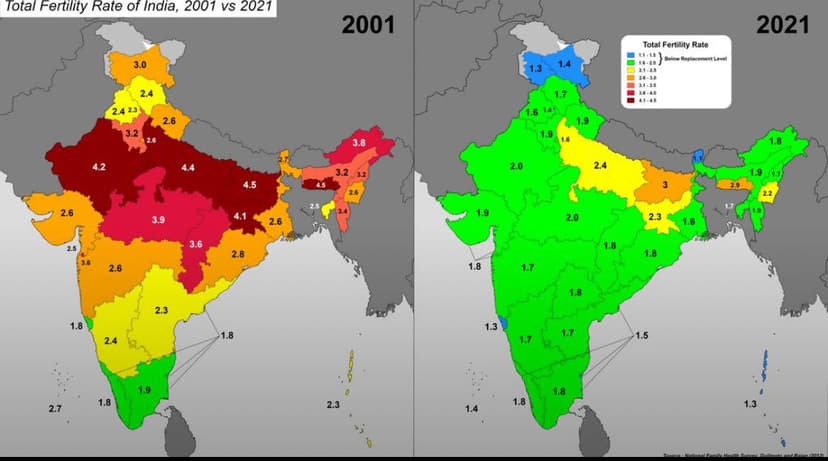Interesting comparison: Fertility rates 2001 vs 2021
-
2001: A majority of states had a TFR above the replacement level of 2.1, with several states in the northern and central regions showing significantly higher rates (e.g., Uttar Pradesh at 4.4, Bihar at 4.5).
-
2021: Most states have reduced their TFR to or below the replacement level. Notably, states like Uttar Pradesh and Bihar, which previously had high TFRs, now show reduced figures (2.4 and 3, respectively). The southern and western states exhibit some of the lowest TFRs, such as Kerala (1.8) and Maharashtra (1.7).
This shift indicates a transition towards stabilization in population growth, which can have significant implications for resource management, economic planning, and social policies in India.
Considering everything while may lead to better quality of life as resource per child will increase but on other hand in next 100 or 200 years, our country might face aging problem. Also, this will lead to change in traditional family structures. We might stop seeing joint family structures.
What else do you think might be a positive or negative outcome of this?

Talking product sense with Ridhi
9 min AI interview5 questions

Joint Families are way over rated - prople lead suffocating lives. Also..dont really care what happens 200 years down the line.
There are both advantages and disadvantages to it. Depends on the nature of a person and their preferences.

suits patriachal constructs fine. modern day folk are usually nuclear. I and my wife, my brother and his wife. We still meet up with parents and have a great time without compromising on our own private spaces.

Indian people are socially connected way better then any western country. We don't take appointments to meet our relatives. We definitely need very less population compared to what we have now.
Leave apart any other factor and just focus how far we have used our natural resources including fresh drinking water. We definitely need 30-40 cr less people right at this point in our country. See the unemployment and then talk about it.
All the major issues in our country are only and only due to over population right from corruption, reservation etc

I second this

Fan of Thanos

3.5 LKG school fees is the reason.
Ha ha…I doubt that. Lower your standards and there are bunch of options available.

Inflation is the best contraceptive

Abey student ho padhai wadhai me dil lagao ye kya sexsux pe gyan oel rahey😂

True

Work pressure.and poor WLB

I had previously ranted somewhere on gv that India might as well grow old before it becomes rich. primarily attributing to policies penalising productive workforce and incentivising freeloading.
But buddhijivis claim it's a feature not a bug.
People love data and visuals 🤓

Just as people earn more. They have less kids.
If you look at trends - Two segments of people have lots of kids - The ultra rich and the poor.
Reason - the wants kids to manage their empire or business The poor wants kids to contribute to the household income

No issue... UP and Bihar will fight for the rest of India. Eventually, whole india will be united up and Bihar

If life on earth sustains for another 100-200 years I feel the majority population will be in Africa and might see history repeat itself but with change in dominance.

